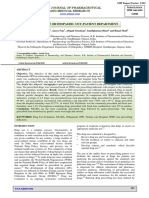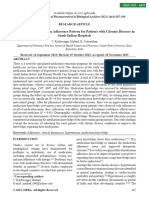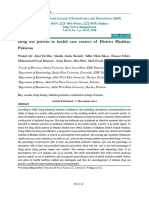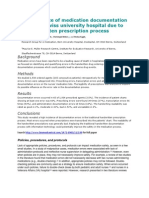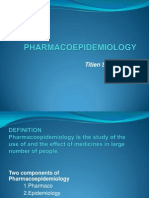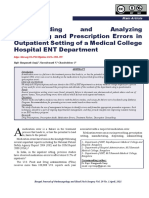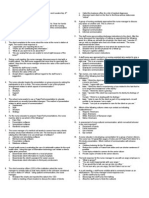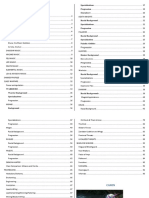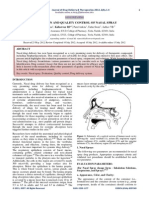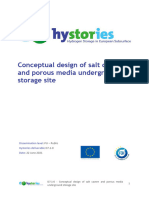Professional Documents
Culture Documents
Assessment of Appropriateness of Medical Prescriptions in Community Pharmacies and Adoption of WHO Prescribing Indicators
Assessment of Appropriateness of Medical Prescriptions in Community Pharmacies and Adoption of WHO Prescribing Indicators
Copyright
Available Formats
Share this document
Did you find this document useful?
Is this content inappropriate?
Report this DocumentCopyright:
Available Formats
Assessment of Appropriateness of Medical Prescriptions in Community Pharmacies and Adoption of WHO Prescribing Indicators
Assessment of Appropriateness of Medical Prescriptions in Community Pharmacies and Adoption of WHO Prescribing Indicators
Copyright:
Available Formats
Volume 8, Issue 12, December – 2023 International Journal of Innovative Science and Research Technology
ISSN No:-2456-2165
Assessment of Appropriateness of Medical
Prescriptions in Community Pharmacies and
Adoption of WHO Prescribing Indicators
M Kumaraswamy1, Harshitha V*1, Anvil Preem Rebello1, Rithesh Patel1, Sanjay Gowda AV1, Chandrakala D1
1
Department of Pharmacy Practice, Sri Adichunchanagiri College of Pharmacy, B G Nagara, Karnataka (571448) India
Corresponding Author:- Harshitha V*
Department of Pharmacy practice
Sri Adichunchanagiri college of pharmacy,
B G Nagara, Karnataka (571448) India
Abstract:- Prescription auditing is critical because auditing is critical because poor prescribing practices, such as
improper prescribing practices, such as medication medication misuse, overuse, and underuse, can result in risky
abuse, overuse, and underuse, can result in patient treatment, a worsening of the illness, health risks, financial
financial hardship, dangerous treatment, and resource hardship for the patients, and resource waste. One can
waste, particularly in community pharmacies. This study distinguish between the technical and conceptual components
was aimed to determine the appropriateness of medical of a prescription. The cognitive component involves making
prescriptions dispensed in community pharmacy. 1,010 decisions, which involves comprehending the diagnosis,
prescriptions filled in the three community pharmacies medication interactions, and prescription contraindications.
during a six-month period were gathered for a The technical portion is providing the pharmacists with
prospective observational study. The World Health essential information, like the drug's name and dosage [2,3].
Organization's basic drug prescribing indicators were
used to analyze each prescription, and an additional 16 By raising the bar for medical care at every stage of the
essentials were evaluated. The findings demonstrated that health care delivery system, people's quality of life can be
the proportion of medications prescribed under generic enhanced. The compliance with these guidelines is monitored
names was significantly lower than the WHO- by a medical audit [4,5]. Prescription auditing requires us to
recommended ideal value. It is recommended that analyze the following parameters: department, clinical
prescribers get ongoing education regarding appropriate diagnosis, prescribing criteria, patient demographics, doctor
prescription practices and incentives for writing name and signature [5,6]. Inappropriate use of drugs is
prescriptions for generic medications. To meet the WHO believed to be more of an issue in the Global South. Given
core criteria of medication prescribing, we advise that between 25% and 70% of global health care spending is
prescribers to be aware of the importance of safe and allocated to pharmaceuticals, this could have an impact on
rational prescribing practices, and to receive frequent health care expenditures [7,8].
training, evaluation, and monitoring.
Research conducted throughout India has revealed that
Keywords:- Prescription Auditing; World Health nearly all handwritten prescriptions lacked patient
Organization; Rational Prescribing; Community Pharmacy; information when audited. The World Health Organization
Generic Name. (WHO) promoted improved patient management and
pharmaceutical use by developing prescribing indicators to
I. INTRODUCTION analyze prescriptions. The number of medications prescribed
each contact, the proportion of medications provided by
Prescription auditing is an ongoing cycle that includes generic name, the proportion of encounters involving
practice observation, standard-setting, practice comparison injections and prescriptions for antibiotics, and the proportion
with standards, change implementation, and practice of medications recommended from the Essential Medicine
observation of new practices. It is a thorough, critical List (EML) were among the prescribing indicators [8,9].
examination of the standard of medical care, covering the
methods utilized for diagnosis and treatment, the utilization Upon analysis, it was discovered that the prescriptions
of resources, the final result, and the patients' quality of life. lacked information regarding the patient's history, physical
It is based on documented data to back up the diagnosis, examination, diagnosis, and investigations. The reasons may
course of care, and sensible application of hospital resources. include a high volume of cases in the outpatient department,
For the public, patients, health care management, and vague concerns, or doctors communicating verbally rather
medical practitioners, effective prescription auditing is than in writing. In addition, prescribing errors involving
essential. It helps medical practitioners ensure that their dosage calculations and treatment duration omissions were
patients get the finest care possible [1,2]. Prescription pattern prevalent in 26.7% and 27.5% of cases, respectively.
IJISRT23DEC811 www.ijisrt.com 1027
Volume 8, Issue 12, December – 2023 International Journal of Innovative Science and Research Technology
ISSN No:-2456-2165
Recurring dose, duration, and omission errors were the most A. Assessment part 1
common forms of prescribing errors seen in multiple The following details were evaluated for each
international studies [3,8,10,11]. Prescription auditing aids in prescription: Patient information included: Name, gender,
evaluating the volume of patient-related data included on address, and age of the patient, Prescription is Legible, Drug
prescriptions, professional prescribing practices, the name correctly mentioned Block capitals are used, Dosage
appropriateness of drug availability and usage, drug Form clearly written, Dose with clear Units, Route of
dispensing procedures, and dispensary workload [12]. Administration stated, Frequency of Dose mentioned,
Presence of Therapeutic Duplication, Drug-Drug
II. METHODOLOGY Interactions, Date, Signature Name & address of prescriber.
Item was scored depending on whether the pertinent piece of
A Prospective and Observational study is conducted in information was missing (0) or present (1).
selected community pharmacies namely, Mahaveera
Medicals, Cheluva Store & Fathima Medicals in and around B. Assessment part 2
Bellur, B.G Nagara. In order to compile a representative The primary prescribing metrics evaluated were:
sample of the community pharmacy population, a total of Quantity of prescribed drugs
1,010 prescriptions filled over the course of six months were Number of prescription items for generic drugs
dispensed at three different community pharmacies. Each Quantity of prescribed antibiotics
participating pharmacist collected information on patients' Quantity of prescribed injections
age, gender, diagnosis, specialty of the prescribing physician, Quantity of prescription medications from the essential
name of the medications in each prescription, dosage, and drug list (EDL).
quantity of medications dispensed, all while maintaining the
confidentiality of all personal data from each prescription, III. STATISTICAL ANALYSIS:
including the patient's name and address. This was done with
the patient's oral and written consent. Data were entered into Microsoft Excel spread sheets
and cross checked for its accuracy. The statistical analysis
was performed using Microsoft Excel for windows.
IV. RESULTS
Table 1: Percentage of prescriptions with different criteria mentioned in it.
Criteria Frequency Percent
Name of patient mentioned 1010 100%
Gender 842 83.36%
Address of patient mentioned 168 16.63%
Age of patient mentioned 926 91.68%
Prescription is legible 169 16.73%
Drug name correctly mentioned 169 16.73%
Block capitals are used 84 8.31%
Dosage form clearly written 842 83.3%
Dose with clear units 926 91.68%
Route of administration stated 589 58.31%
Frequency of dose mentioned 785 77.72%
Presence of therapeutic duplication 112 11.08%
Drug interactions 120 11.88%
Date 898 88.91%
Signature 692 68.5%
Name and address of prescriber 1010 100%
Table 2: WHO criteria of prescribing indicators
Average number % of drugs prescribed % of prescriptions % of injections % of drugs prescribed
of drugs in generic name containing antibiotics from EDL
2.96% 16% 17% 13.33% 40.49%
IJISRT23DEC811 www.ijisrt.com 1028
Volume 8, Issue 12, December – 2023 International Journal of Innovative Science and Research Technology
ISSN No:-2456-2165
2.96% V. DISCUSSION
16% Prescription clarity is the most crucial prerequisite for
40.49%
prescription writing. It should be easy to read and specify
exactly what needs to be provided [13]. In this study, the
17% 1010 prescriptions were collected from community
pharmacies and analyzed. In our analysis, 50.39% of
prescriptions were from females and 49.60% from males. In
13.33% comparable research by Kaur and Walia, the population was
dominated by men (54.2%) and women (44.8%) [14]. There
were 46.73% females and 53.27% males in a research by
Darji et al. [15]. In a different study by Kumar and
Average number of drugs Rajasekhar, 52% of participants were women and 58% were
% of drugs prescribed in generic name men. When analyzing WHO core prescribing indicators,
average number of medicines per prescription was 3 as per
% of prescriptions containing antibiotics this study. The WHO proposes less than 2 to be an optimal
value [Table 3].
% of injections
% of drugs prescribed from EDL
Fig 1 WHO Criteria of Prescribing Indicators
Table 3: Comparison of WHO core drug use prescribing indicators
Prescribing indicators Optimal values Values obtained in the audit
Average number of medicines per prescription <2 3
Percentage of medicines prescribed by generic name 100% 16%
Percentage of antibiotics per prescription <30% 17%
Percentage of injections per prescription <20% 13.33%
Percentage of medicines prescribed from the essential drug list 100% 40.49%
In the study of Kaur and Walia, the average number of prescribing patterns and indicators as well as how they relate
medications per prescription was 8.8 [14]. The average to the WHO core prescribing indicators. This aids in
number of medications per prescription was 6.49 out of 302 understanding the areas of patient care that require
prescriptions with 1986 medications in a study by Darji et al. improvement in our environment as well as the present
[15] and 1.8 out of 1440 prescriptions with 2610 medications prescribing practices. This study's limitation is that it was
assessed in a study by Bekele and Tadesse [18]. A high value conducted for a set amount of time only. Prescription
could result from monetary rewards, ongoing marketing auditing should, however, be a continuous procedure carried
campaigns by suppliers, or prescribers' lack of therapeutic out on a regular basis. It will support the monitoring of
training [16]. In contrast to research by Kaur and Walia [14], prescribing procedures and identify areas in need of
our analysis found that 16% of medications were prescribed improvement. The appropriate authorities can make
under their generic names. According to the WHO, 100 was adjustments if they are aware of the necessary corrections to
the ideal figure. Prescription rules are adhered to when provide high-quality patient care [13].
medications are prescribed from the essential medicine list or
in generic form. The low value could be the result of a lack VI. CONCLUSION
of trust in generic medications, a preference for branded
medications, or the unavailability of generic drugs [13]. The primary objectives of the research were to assess
the suitability of medical prescriptions filled in community
In our investigation, 16 percent of the prescriptions pharmacies and to identify any possible drug-drug
were readable. interactions by looking at the kind, quantity, and occurrence
of such interactions. Certain prescribing indicators in our
97.01% of legitimate prescriptions were recorded by study, such as the percentage of medications prescribed from
Bekele and Tadesse, and 86.8% by Kaur and Walia [14]. the essential drug list, the percentage of medications
Compared to Bekele and Tadesse, where it was 93.54%, the prescribed by generic name, and the average number of
doctor's signature was found on 68% of prescriptions [13]. medications per prescription, deviated from WHO guidelines,
Clarity in the prescription is the most crucial prerequisite for while other indicators, such as the percentage of prescriptions
prescription writing [17]. It should be easy to read and clearly for antibiotics and injections, were within optimal ranges.
outline the requirements for submission. Writing clearly is Merely 16% of the prescriptions were readable, which could
required by law. Our study's conclusions suggest that several be attributed to inadequate time and ignorance of the most
prescribing practices should be improved. This study's recent WHO criteria. The percentage of medications
strength is that it provides information on our setting's prescribed under generic names was much lower than the
IJISRT23DEC811 www.ijisrt.com 1029
Volume 8, Issue 12, December – 2023 International Journal of Innovative Science and Research Technology
ISSN No:-2456-2165
ideal level, according to the results. Although the average [9]. Shelat PR, Kumbar SK. Analysis of out door Patients’
number of prescriptions written per contact was somewhat prescriptions according to World Health Organization
over the ideal level, this nevertheless indicates (WHO) prescribing indicators among private hospitals
polypharmacy, which raises the possibility of prescription in Western India. Journal of Clinical and Diagnostic
errors. Errors in prescription might have negative Research. 2015;9(3).
repercussions and hurt patients. We propose that prescribers [10]. Mishra S, Sharma P. Prescription audit and drug
should get ongoing training on rational prescribing, as well as utilization pattern in a tertiary care teaching hospital in
incentives to write prescriptions using generic names and BHOPAL. Int J Basic Clin Pharmacol. 2016;
items from the essential drug list or formulary list. To meet [11]. Seden K, Kirkham JJ, Kennedy T, Lloyd M, James S,
the WHO core criteria of medication prescribing, we advise McManus A, et al. Cross-sectional study of prescribing
prescribers and medical students to be aware of the need of errors in patients admitted to nine hospitals across North
safe and rational prescribing, as well as to receive regular West England. BMJ Open. 2013;3(1).
training, evaluation, and monitoring. Standard treatment [12]. Kiekkas P, Karga M, Lemonidou C, Aretha D,
guidelines have proved useful and effective in promoting Karanikolas M. Medication errors in critically ill adults:
rational and safe drug use. A review of direct observation evidence. American
Journal of Critical Care. 2011;20(1).
CONFLICT OF INTEREST [13]. Bekele NA, Tadesse J. Prescription auditing based on
World Health Organization (WHO) prescribing
The authors declare no conflict of interest. indicators: A case of Dilla University referral hospital.
Journal of Drug Delivery and Therapeutics. 2018;8(6-s).
FUNDING [14]. Kaur B, Walia R. PRESCRIPTION AUDIT FOR
EVALUATION OF PRESCRIBING PATTERN OF
There was no dedicated grant for the evaluation from THE DOCTORS FOR RATIONAL DRUG THERAPY
any public, commercial, or non profit organization. IN A TERTIARY CARE HOSPITAL. Journal of Drug
Delivery and Therapeutics. 2013;3(5).
REFERENCES [15]. Darji N, Vaniya H, Doshi C, Hedamba R, Jadav S,
Trivedi H. Prescription audit in the inpatients of a
[1]. Bandyopadhyay D. A STUDY OF PRESCRIPTION tertiary care hospital attached with medical college.
AUDITING IN A TERTIARY CARE TEACHING Journal of Clinical & Experimental Research.
HOSPITAL OF EASTERN INDIA. Journal of Drug 2015;3(2).
Delivery and Therapeutics. 2014 Jan 15;4(1). [16]. Desta Z, Abula T, Gebre-Yohannes A, Worku A. Drug
[2]. U. S. NK, G. K. N, P. D, M. P, Rathod G, N. M. prescribing patterns for outpatients in three hospitals in
Prescription audit of outpatients in tertiary care north-west Ethiopia. Ethiopian Journal of Health
government hospital. Int J Basic Clin Pharmacol. Development. 2002;16(2).
2018;7(4). [17]. SURABHI ARORA, AFROZ ABIDI, DILSHAD ALI
[3]. Abidi A, Gupta S, Kansal S, Ramgopal R. Prescription RIZVI. A PRESCRIPTION AUDIT AND
auditing and drug utilization pattern in a tertiary care ASSESSMENT OF DRUG UTILIZATION PATTERN
teaching hospital of western UP. Int J Basic Clin IN A TERTIARY CARE TEACHING AND
Pharmacol. 2012;1(3). REFERRAL HOSPITAL IN UTTAR PRADESH,
[4]. Curtis P. Medical audit in general practice. Journal of INDIA. Asian Journal of Pharmaceutical and Clinical
the Royal College of General Practitioners. Research. 2019;
1974;24(146).
[5]. Dhavalshankh AG, Rajadnya VA, Patil KL.
Prescription auditing: an important tool for sensitization
of resident doctors for rationale prescription and
utilization of drug. Int J Basic Clin Pharmacol.
2019;8(10).
[6]. Gross F. Drug utilization - Theory and practice the
present situation in the Federal Republic of Germany.
Eur J Clin Pharmacol. 1981;19(6).
[7]. Edition ND. Measuring medicine prices, availability,
affordability and price components 2nd edition. In:
WHO/HAI. 2008.
[8]. Singh T, Banerjee B, Garg S, Sharma S. A prescription
audit using the World Health Organization-
recommended core drug use indicators in a rural
hospital of Delhi. J Educ Health Promot. 2019;8(1).
IJISRT23DEC811 www.ijisrt.com 1030
You might also like
- Engdahl, William - Seeds of Destruction. The Hidden Agenda of Genetic ManipulationDocument360 pagesEngdahl, William - Seeds of Destruction. The Hidden Agenda of Genetic ManipulationAaban Khan100% (7)
- A Retrospective Observational Study To Determine The Percentage of Drugs Prescribed by Generic Names in ICU of A Tertiary Care Hospital in Dakshina KannadaDocument6 pagesA Retrospective Observational Study To Determine The Percentage of Drugs Prescribed by Generic Names in ICU of A Tertiary Care Hospital in Dakshina KannadaIJPS : A Pharmaceutical JournalNo ratings yet
- Clinical Pharmacist Role in Drug Information ServiDocument9 pagesClinical Pharmacist Role in Drug Information ServiDesalegn DansaNo ratings yet
- Dhanya Kerala 2021Document5 pagesDhanya Kerala 2021xyzNo ratings yet
- Article 1596189027Document6 pagesArticle 1596189027PromNo ratings yet
- Rational Drug Use NoteDocument14 pagesRational Drug Use NoteSteven A'Baqr EgiliNo ratings yet
- Developing A Measure For The Appropriateness of Prescribing in General PracticeDocument5 pagesDeveloping A Measure For The Appropriateness of Prescribing in General Practiceujangketul62No ratings yet
- Who Core Prescribing Indicators and Its Effects On Quality of Life in Patients With Superficial Fungal InfectionsDocument11 pagesWho Core Prescribing Indicators and Its Effects On Quality of Life in Patients With Superficial Fungal InfectionsIJAR JOURNALNo ratings yet
- Drug Utilization Study IJPhS-76-308Document7 pagesDrug Utilization Study IJPhS-76-308rikanopitaNo ratings yet
- Prescription Completeness and Drug Use PatternDocument7 pagesPrescription Completeness and Drug Use Patternadane yehualawNo ratings yet
- The Study of Drug Usage Patterns in Pediatric Patients at MGM Hospital, Navi MumbaiDocument10 pagesThe Study of Drug Usage Patterns in Pediatric Patients at MGM Hospital, Navi Mumbairajesh sumanNo ratings yet
- Adherence 4Document10 pagesAdherence 4NajeebNo ratings yet
- Drug Use in Ophthalmology Out-Patient Department: A Prospective Study at A Tertiary Care Teaching HospitalDocument6 pagesDrug Use in Ophthalmology Out-Patient Department: A Prospective Study at A Tertiary Care Teaching HospitalHania AwadNo ratings yet
- Mr. Hariom Rajput Mr. Ramsingh Ji Gmail-ID International Association of Oncology (IAO) Government of IndiaDocument6 pagesMr. Hariom Rajput Mr. Ramsingh Ji Gmail-ID International Association of Oncology (IAO) Government of IndiaHariom RajputNo ratings yet
- "Adjuvant Drugs" Based On Evidence-Based Medicine: Construction of Scientific Management Mode ofDocument9 pages"Adjuvant Drugs" Based On Evidence-Based Medicine: Construction of Scientific Management Mode ofvinayNo ratings yet
- Ceftriaxone, IndiaDocument5 pagesCeftriaxone, IndiaTya ALditsa SadegaNo ratings yet
- Drug Prescribing Pattern and Prescription Error in Elderly: A Retrospective Study of Inpatient RecordDocument5 pagesDrug Prescribing Pattern and Prescription Error in Elderly: A Retrospective Study of Inpatient RecordhukamaNo ratings yet
- Drug Utilization Patterns Using Who Core Prescribing Indicators in Different Out Patient Departments at Secondary Care Hospital, KarimnagarDocument9 pagesDrug Utilization Patterns Using Who Core Prescribing Indicators in Different Out Patient Departments at Secondary Care Hospital, KarimnagarIJAR JOURNALNo ratings yet
- Antibiotics 06 00023 v2Document12 pagesAntibiotics 06 00023 v2andrea rabangNo ratings yet
- Common Prescription Errors in Opd of A Tertiary Care Teaching Hospital - January - 2022 - 1341758106 - 9720321Document3 pagesCommon Prescription Errors in Opd of A Tertiary Care Teaching Hospital - January - 2022 - 1341758106 - 9720321sanjay yadavNo ratings yet
- Drug Utilization Study in The Department of Medicine at A Teaching HospitalDocument11 pagesDrug Utilization Study in The Department of Medicine at A Teaching HospitalFaizan Ali UniqueNo ratings yet
- Drug Prescribing and Dispensing Pattern in PediatrDocument6 pagesDrug Prescribing and Dispensing Pattern in PediatrAestherielle SeraphineNo ratings yet
- Irrational UseDocument8 pagesIrrational UseNilisha PradhanNo ratings yet
- A Study of Prescription Audit in Inpatient Department of Tertiary Care Hospital, PuneDocument7 pagesA Study of Prescription Audit in Inpatient Department of Tertiary Care Hospital, PuneBaru Chandrasekhar RaoNo ratings yet
- Artigo Sobre TromboembolismoDocument8 pagesArtigo Sobre TromboembolismoJohnattanNo ratings yet
- Ka 2Document8 pagesKa 2DHIVYANo ratings yet
- Pharmacology REPORTDocument19 pagesPharmacology REPORTPankaj SharmaNo ratings yet
- SAQ127 Indicators 3.2Document4 pagesSAQ127 Indicators 3.2Edi Uchiha SutarmantoNo ratings yet
- Factors Associated With Irrational Drug Use at A District Hospital in Zambia: Patient Record-Based ObservationsDocument6 pagesFactors Associated With Irrational Drug Use at A District Hospital in Zambia: Patient Record-Based ObservationsKevin SaulNo ratings yet
- A Review On Prescription Pattern Monitoring Studies in Different Areas of IndiaDocument9 pagesA Review On Prescription Pattern Monitoring Studies in Different Areas of IndiaSarbjeet SinghNo ratings yet
- Analysis of The Prescription Pattern of Psychotropics I 2022 Medical JournalDocument6 pagesAnalysis of The Prescription Pattern of Psychotropics I 2022 Medical JournalAnisha RanaNo ratings yet
- Jurnal PC 2Document22 pagesJurnal PC 2Dedi LihawaNo ratings yet
- Jurnal Epo 1Document7 pagesJurnal Epo 1Evelin VelinnNo ratings yet
- Griese Mammen2018Document19 pagesGriese Mammen2018Keytiane JVNo ratings yet
- What Phytotherapy Needs: Evidence Based Guidelines For Better Clinical PracticeDocument13 pagesWhat Phytotherapy Needs: Evidence Based Guidelines For Better Clinical PracticeLGMOQNo ratings yet
- International Research Journal of PharmacyDocument5 pagesInternational Research Journal of PharmacyKoko DandashNo ratings yet
- 05 Ijpba 2097 23Document10 pages05 Ijpba 2097 23BRNSS Publication Hub InfoNo ratings yet
- Articulo FarmacoepidemiologiaDocument36 pagesArticulo FarmacoepidemiologiaEdilma VargasNo ratings yet
- Evaluation of Drug Related Problems in Patients With Chronic Disease at Tertiary Care Teaching HospitalDocument12 pagesEvaluation of Drug Related Problems in Patients With Chronic Disease at Tertiary Care Teaching HospitalenesNo ratings yet
- Drug Use Pattern in Health Care Centers of District Bhakkar, PakistanDocument6 pagesDrug Use Pattern in Health Care Centers of District Bhakkar, PakistanOpenaccess Research paperNo ratings yet
- Ijetmas PaperDocument11 pagesIjetmas PaperAshu TyagiNo ratings yet
- MedicationerrorsDocument11 pagesMedicationerrorsIkhwanir RaisaNo ratings yet
- Drug ChartDocument3 pagesDrug ChartanurajoneNo ratings yet
- Revised Drug Information PDFDocument19 pagesRevised Drug Information PDFvaseem9in100% (1)
- 2018 - Wigiyantoro & DarmawanDocument11 pages2018 - Wigiyantoro & DarmawanazeemathmariyamNo ratings yet
- A Study On Rational Drug Prescribing andDocument8 pagesA Study On Rational Drug Prescribing andashenafi woldesenbetNo ratings yet
- Beliefs and Attitudes of Generic Versus Original Drugs Among Doctors in A Tertiary-Care Hospital in Western IndiaDocument6 pagesBeliefs and Attitudes of Generic Versus Original Drugs Among Doctors in A Tertiary-Care Hospital in Western IndiaHavarbaniNo ratings yet
- Biblio Comp Guias Rol Farmaceutico en Gestion Informacion - ASHP - 2015Document5 pagesBiblio Comp Guias Rol Farmaceutico en Gestion Informacion - ASHP - 2015Lula BilloudNo ratings yet
- A Review On Essential Medicines and Rational UsageDocument15 pagesA Review On Essential Medicines and Rational Usage丘嘉豪No ratings yet
- Adherence and Medication Adherence Rating Scale (MARS)Document4 pagesAdherence and Medication Adherence Rating Scale (MARS)International Journal of Innovative Science and Research TechnologyNo ratings yet
- Introduction PeDocument33 pagesIntroduction PezmekitNo ratings yet
- Medication Appropriatness IndexDocument3 pagesMedication Appropriatness IndexUber Hermann Arguedas RíosNo ratings yet
- Rational Use of Medicines: Prescribing Indicators at Different Levels of Health CareDocument12 pagesRational Use of Medicines: Prescribing Indicators at Different Levels of Health Careastiari ardiniNo ratings yet
- Decentralized Pharmacist' ServicesDocument21 pagesDecentralized Pharmacist' ServicesRaju NiraulaNo ratings yet
- Factors Affecting Prescribing BHR - Dar EselamDocument7 pagesFactors Affecting Prescribing BHR - Dar EselamWassie GetahunNo ratings yet
- Chapter - 2 Rational Drug Use: Health Administrator Vol: XIX Number 1: 5-7Document3 pagesChapter - 2 Rational Drug Use: Health Administrator Vol: XIX Number 1: 5-7mayapuspitasariunsriNo ratings yet
- Rab 8Document21 pagesRab 8Belia DestamaNo ratings yet
- Drug Utilisation Study of UTIDocument4 pagesDrug Utilisation Study of UTIviva.anu24No ratings yet
- Medication Error Factors, Safety Guideline System, Flow of Drug Usage, and Code of Conduct To Prevent Medication ErrorDocument5 pagesMedication Error Factors, Safety Guideline System, Flow of Drug Usage, and Code of Conduct To Prevent Medication ErrorskyNo ratings yet
- 395-Main Article-1737-1-10-20210603Document11 pages395-Main Article-1737-1-10-20210603فاتن محمدNo ratings yet
- Exploring the Potential Advantages of Traditional Therapies in Autoimmune Blistering Illnesses: A Comprehensive Review and Analysis, ResearchDocument12 pagesExploring the Potential Advantages of Traditional Therapies in Autoimmune Blistering Illnesses: A Comprehensive Review and Analysis, ResearchInternational Journal of Innovative Science and Research TechnologyNo ratings yet
- Design and Development of Multi-Featured Medical StretcherDocument4 pagesDesign and Development of Multi-Featured Medical StretcherInternational Journal of Innovative Science and Research TechnologyNo ratings yet
- Seasonal Variation and Distribution Patterns of Endophytic Community in Withania somniferaDocument7 pagesSeasonal Variation and Distribution Patterns of Endophytic Community in Withania somniferaInternational Journal of Innovative Science and Research TechnologyNo ratings yet
- EmoConnect: Nurturing Trust and Relationship Bonds in Alzheimer’s ConversationsDocument3 pagesEmoConnect: Nurturing Trust and Relationship Bonds in Alzheimer’s ConversationsInternational Journal of Innovative Science and Research TechnologyNo ratings yet
- Solar Based Multilevel Inverter f o r BLDC Motor DriveDocument8 pagesSolar Based Multilevel Inverter f o r BLDC Motor DriveInternational Journal of Innovative Science and Research TechnologyNo ratings yet
- Skin Disease Detection and Remedial SystemDocument7 pagesSkin Disease Detection and Remedial SystemInternational Journal of Innovative Science and Research TechnologyNo ratings yet
- Unlocking Sentiments: Enhancing IOCL Petrol Pump ExperiencesDocument8 pagesUnlocking Sentiments: Enhancing IOCL Petrol Pump ExperiencesInternational Journal of Innovative Science and Research TechnologyNo ratings yet
- Smart and Secure Home with ChatbotDocument9 pagesSmart and Secure Home with ChatbotInternational Journal of Innovative Science and Research TechnologyNo ratings yet
- Firm Size as a Mediator between Inventory Management Andperformance of Nigerian CompaniesDocument8 pagesFirm Size as a Mediator between Inventory Management Andperformance of Nigerian CompaniesInternational Journal of Innovative Science and Research TechnologyNo ratings yet
- Preparation and Identification of Magnetic Iron Nanoparticle based on a Natural Hydrogel and its Performance in Targeted Drug DeliveryDocument17 pagesPreparation and Identification of Magnetic Iron Nanoparticle based on a Natural Hydrogel and its Performance in Targeted Drug DeliveryInternational Journal of Innovative Science and Research TechnologyNo ratings yet
- Development of Smart Ground Fault Location Model for Radial Distribution SystemDocument14 pagesDevelopment of Smart Ground Fault Location Model for Radial Distribution SystemInternational Journal of Innovative Science and Research TechnologyNo ratings yet
- Application of Plant Growth Promoting Rhizobacteria on Vegetative Growth in Chili Plants (Capsicum frutescens L.)Document7 pagesApplication of Plant Growth Promoting Rhizobacteria on Vegetative Growth in Chili Plants (Capsicum frutescens L.)International Journal of Innovative Science and Research TechnologyNo ratings yet
- On the Development of a Threat Driven Model for Campus NetworkDocument14 pagesOn the Development of a Threat Driven Model for Campus NetworkInternational Journal of Innovative Science and Research TechnologyNo ratings yet
- Reading Intervention Through “Brigada Sa Pagbasa”: Viewpoint of Primary Grade TeachersDocument3 pagesReading Intervention Through “Brigada Sa Pagbasa”: Viewpoint of Primary Grade TeachersInternational Journal of Innovative Science and Research TechnologyNo ratings yet
- Global Warming Reduction Proposal AssessmentDocument6 pagesGlobal Warming Reduction Proposal AssessmentInternational Journal of Innovative Science and Research TechnologyNo ratings yet
- PHREEQ C Modelling Tool Application to Determine the Effect of Anions on Speciation of Selected Metals in Water Systems within Kajiado North Constituency in KenyaDocument71 pagesPHREEQ C Modelling Tool Application to Determine the Effect of Anions on Speciation of Selected Metals in Water Systems within Kajiado North Constituency in KenyaInternational Journal of Innovative Science and Research TechnologyNo ratings yet
- Exploring the Post-Annealing Influence on Stannous Oxide Thin Films via Chemical Bath Deposition Technique: Unveiling Structural, Optical, and Electrical DynamicsDocument7 pagesExploring the Post-Annealing Influence on Stannous Oxide Thin Films via Chemical Bath Deposition Technique: Unveiling Structural, Optical, and Electrical DynamicsInternational Journal of Innovative Science and Research TechnologyNo ratings yet
- Application of Game Theory in Solving Urban Water Challenges in Ibadan-North Local Government Area, Oyo State, NigeriaDocument9 pagesApplication of Game Theory in Solving Urban Water Challenges in Ibadan-North Local Government Area, Oyo State, NigeriaInternational Journal of Innovative Science and Research TechnologyNo ratings yet
- Investigating Non-Newtonian Fluid Behavior in Hydrocyclones Via Computational Fluid DynamicsDocument18 pagesInvestigating Non-Newtonian Fluid Behavior in Hydrocyclones Via Computational Fluid DynamicsInternational Journal of Innovative Science and Research TechnologyNo ratings yet
- Esophageal Melanoma - A Rare NeoplasmDocument3 pagesEsophageal Melanoma - A Rare NeoplasmInternational Journal of Innovative Science and Research TechnologyNo ratings yet
- A Study to Assess the Knowledge Regarding Teratogens Among the Husbands of Antenatal Mother Visiting Obstetrics and Gynecology OPD of Sharda Hospital, Greater Noida, UpDocument5 pagesA Study to Assess the Knowledge Regarding Teratogens Among the Husbands of Antenatal Mother Visiting Obstetrics and Gynecology OPD of Sharda Hospital, Greater Noida, UpInternational Journal of Innovative Science and Research TechnologyNo ratings yet
- Detection of Phishing WebsitesDocument6 pagesDetection of Phishing WebsitesInternational Journal of Innovative Science and Research TechnologyNo ratings yet
- Mandibular Mass Revealing Vesicular Thyroid Carcinoma A Case ReportDocument5 pagesMandibular Mass Revealing Vesicular Thyroid Carcinoma A Case ReportInternational Journal of Innovative Science and Research TechnologyNo ratings yet
- Consistent Robust Analytical Approach for Outlier Detection in Multivariate Data using Isolation Forest and Local Outlier FactorDocument5 pagesConsistent Robust Analytical Approach for Outlier Detection in Multivariate Data using Isolation Forest and Local Outlier FactorInternational Journal of Innovative Science and Research TechnologyNo ratings yet
- Vertical Farming System Based on IoTDocument6 pagesVertical Farming System Based on IoTInternational Journal of Innovative Science and Research TechnologyNo ratings yet
- Sustainable Energy Consumption Analysis through Data Driven InsightsDocument16 pagesSustainable Energy Consumption Analysis through Data Driven InsightsInternational Journal of Innovative Science and Research TechnologyNo ratings yet
- The Impact of Music on Orchid plants Growth in Polyhouse EnvironmentsDocument5 pagesThe Impact of Music on Orchid plants Growth in Polyhouse EnvironmentsInternational Journal of Innovative Science and Research Technology100% (1)
- Osho Dynamic Meditation; Improved Stress Reduction in Farmer Determine by using Serum Cortisol and EEG (A Qualitative Study Review)Document8 pagesOsho Dynamic Meditation; Improved Stress Reduction in Farmer Determine by using Serum Cortisol and EEG (A Qualitative Study Review)International Journal of Innovative Science and Research TechnologyNo ratings yet
- Influence of Principals’ Promotion of Professional Development of Teachers on Learners’ Academic Performance in Kenya Certificate of Secondary Education in Kisii County, KenyaDocument13 pagesInfluence of Principals’ Promotion of Professional Development of Teachers on Learners’ Academic Performance in Kenya Certificate of Secondary Education in Kisii County, KenyaInternational Journal of Innovative Science and Research Technology100% (1)
- Realigning Curriculum to Simplify the Challenges of Multi-Graded Teaching in Government Schools of KarnatakaDocument5 pagesRealigning Curriculum to Simplify the Challenges of Multi-Graded Teaching in Government Schools of KarnatakaInternational Journal of Innovative Science and Research TechnologyNo ratings yet
- NLM QuestionsDocument15 pagesNLM Questionsleoboi_leoboi81% (16)
- Molting of Mud Crab (Scylla Serrata) Cultured in CageDocument5 pagesMolting of Mud Crab (Scylla Serrata) Cultured in Cageedendereze6026100% (3)
- Online Food Exchange and Meal Planning For FilipinosDocument2 pagesOnline Food Exchange and Meal Planning For FilipinosJrelHopeNo ratings yet
- Sikh Law of MarriageDocument31 pagesSikh Law of MarriagePrabhjot SinghNo ratings yet
- Shared Warcraft ProfileDocument97 pagesShared Warcraft ProfileBill AndersonNo ratings yet
- Jurnal Sediaan Nasal PDFDocument4 pagesJurnal Sediaan Nasal PDFFeslyAnugerahAriestaPayungNo ratings yet
- Ventilator Icu: Ririn Dwi LestariDocument16 pagesVentilator Icu: Ririn Dwi LestariRirin Dwi Lestari100% (1)
- Stress Management by Meditation and Spiritual ScienceDocument28 pagesStress Management by Meditation and Spiritual Scienceapi-25909027100% (2)
- Adventurer Woodstravel ModuleDocument316 pagesAdventurer Woodstravel Moduleneilmlfd16100% (1)
- LTE Radio Access, Rel. LTE 17A, Operating Documentation, Issue 03Document53 pagesLTE Radio Access, Rel. LTE 17A, Operating Documentation, Issue 03Nicolás RuedaNo ratings yet
- Frankl'd Logotherapy A New Orientation in CounselingDocument14 pagesFrankl'd Logotherapy A New Orientation in CounselingAlan Da Silva VerasNo ratings yet
- Hopdoddy Burger Bar's MenuDocument2 pagesHopdoddy Burger Bar's MenuCurtisNo ratings yet
- Human Anatomy Reading ComprehensionDocument16 pagesHuman Anatomy Reading ComprehensionRhams BairullaNo ratings yet
- TKD Sept Med AovDocument177 pagesTKD Sept Med AovAmritNo ratings yet
- A2 A Lesson Plan On Proper Waste Disposal ManagementDocument27 pagesA2 A Lesson Plan On Proper Waste Disposal ManagementJovelyn SagangNo ratings yet
- MODEL 2800: Horizontal Split-Case PumpsDocument28 pagesMODEL 2800: Horizontal Split-Case PumpsCarlos_MKTRNo ratings yet
- Sub-Total 5,000.00: NO. Description Unit Quantity Unit Cost Total CostDocument2 pagesSub-Total 5,000.00: NO. Description Unit Quantity Unit Cost Total CostKesMercadoNo ratings yet
- General Pathology Practical Exam Renal PathologyDocument16 pagesGeneral Pathology Practical Exam Renal PathologyCherry RahimaNo ratings yet
- LCMFT ListDocument16 pagesLCMFT ListbgsradNo ratings yet
- Boom Lubrication Kit - P/No 04158888: REF.: Parts Bulletin D15-313Document3 pagesBoom Lubrication Kit - P/No 04158888: REF.: Parts Bulletin D15-313Susanth SukumaranNo ratings yet
- Incompatible Chemicals: Safety Basics & RAMPDocument2 pagesIncompatible Chemicals: Safety Basics & RAMPRei Paxley ChristofNo ratings yet
- Biosand Filtration: A Sustainable Option For Household Treatment of Drinking WaterDocument8 pagesBiosand Filtration: A Sustainable Option For Household Treatment of Drinking WaterAbhilash NairNo ratings yet
- Offer of Employment and Employment ContractDocument3 pagesOffer of Employment and Employment ContracttrainershipsolutionsNo ratings yet
- Hystories D7.1 0 Conceptual Design of Storage Site June 2021Document53 pagesHystories D7.1 0 Conceptual Design of Storage Site June 2021F SedighiNo ratings yet
- Case 5 (RBCs Inclusions)Document3 pagesCase 5 (RBCs Inclusions)gaber 230No ratings yet
- EDECDocument41 pagesEDECsowmya G JNo ratings yet
- Mini Case Study - WathenDocument3 pagesMini Case Study - Wathenapi-240148540No ratings yet
- Vision Development - Childhood - American Academy of OphthalmologyDocument1 pageVision Development - Childhood - American Academy of Ophthalmologysneha duttaNo ratings yet
- 2 Parking Garage - Shotcrete - 1002Document1 page2 Parking Garage - Shotcrete - 1002VJ QatarNo ratings yet




